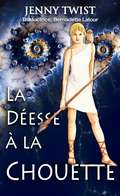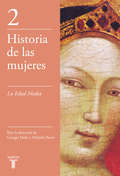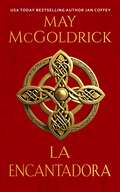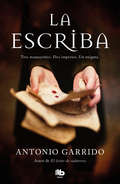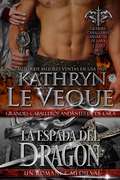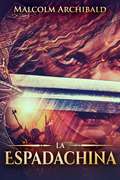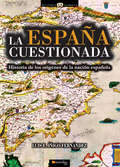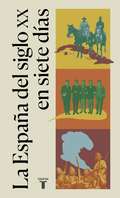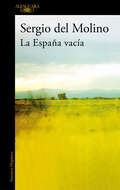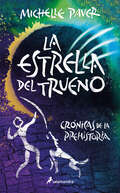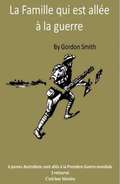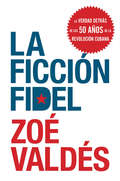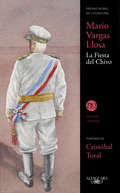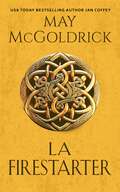- Table View
- List View
La Déesse à la Chouette
by Jenny TwistUn roman basé sur la théorie des 'anciens astronautes' de von Däniken selon laquelle les dieux seraient des voyageurs intergalactiques. L'histoire se passe à l’époque préhistorique du Mésolithique; les principaux protagonistes sont la déesse Athéna jeune fille et Prométhée, un jeune indigène, qui vit dans des caves. Le garçon regarda l'étoile tomber du ciel. Sa chute était très lente et ce n'était pas une lumière mais une multitude de lumières tournoyant paresseusement dans le ciel nocturne. Puis de grands poissons d'argent apparurent dans le ciel et d'autres lumières mystérieuses commencèrent à apparaître sur la montagne. Enfin, un grand coup de foudre frappa l'océan. Le son était plat, creux et incroyablement puissant, comme si un géant avait frappé du pied sur la terre. Et le signe de la déesse est apparu dans le ciel - le signe du champignon sacré. Ce sont les événements qui marquent l'arrivée de l'Atlantide, le vaisseau maudit, apportant de nouveaux dieux qui changeront à jamais la vie du garçon et de son peuple.
La Edad Media: La Edad Media (Historia de las mujeres #Volumen 2)
by Georges DubyEsta obra busca analizar cómo las relaciones de los sexos condicionan la evolución de las sociedades y la necesidad de que las mujeres encuentren, al fin, su espacio propio. Esta Historia de las mujeres responde a la necesidad de ceder la palabra a las mujeres. Alejadas, desde la Antigüedad, del escenario donde se enfrentan a los dueños del destino, reconstruir su historia significa describir su lento acceso a los medios de expresión y su conversión en persona que asume un papel protagonista. Este análisis implica, asimismo, que las relaciones entre los sexos condicionan los acontecimientos, o la evolución de las sociedades. No se buscan conclusiones tajantes sino que las mujeres encuentren, al fin, su espacio propio. Tomando la periodización habitual y el espacio del mundo occidental, esta obra se divide en cinco volúmenes independientes pero complementarios. Este segundo volumen aborda el cambio que para la mujer y su imagen supone la consolidación del cristianismo.
La Encantadora: Trilogía del Tesoro de las Highlands (Trilogía del Tesoro de las Highlands)
by Jan Coffey May McGoldrickTrilogía del Tesoro de las Highlands - Libro 2 Las tres hermanas Percy poseen el secreto de un tesoro perdido hace mucho tiempo y codiciado por el Lord Diputado de Inglaterra. Cada hermana escapa de Inglaterra por diferentes rutas . Huyendo de la persecución del rey inglés, la sensata Laura se refugió en las Highlands de Escocia. Pero cuando se encontró secuestrada por el temible Laird de Blackfearn, todos sus planes bien elaborados se hicieron añicos. Sus maneras temerarias y salvajes dejaron a Laura ardiendo a su paso... ¡y despertaron en ella una pasión tan indómita como la de él!
La Escriba (Histórica Ser.)
by Antonio GarridoUn apasionante thriller histórico inspirado en un hecho real. Alemania, año 799. Carlomagno, rey de Occidente, encarga a Gorgias, un experto escriba bizantino, la traducción de un documento de vital importancia para la cristianidad. Mientras tanto, Theresa, hija de Gorgias y aprendiz de escriba, se ve obligada a huir de Würzburg debido a una falsa acusación y busca de refugio en Fulda, donde conoce a un fraile britano, Alcuino de York. Tras la misteriosa desaparición de Gorgias, Theresa se verá envuelta en una conspiración en la que nada es lo que parece. En compañía de Alcuino, la joven deberá luchar con denuedo para encontrar a su padre y resolver un misterio del que depende el futuro de la cristiandad.
La Espada del Dragón
by Paula Kathryn Le VequeLa Espada del Dragón por Kathryn Le Veque Un caballero maravilloso, una mujer fuerte - determinada y el destino. 1326 A.D. – Tate Crewys de Lara es hijo de reyes. El hijo ilegitimo de Edward Longshanks, Tate tiene las cualidades de un rey maravilloso. Pero el destino es cruel, dejándolo a él como un mero caballero protegiendo al joven Edward III durante los días inciertos que siguieron el horrible asesinato de Edward II. Mientras reunía aliados para el joven heredero en Northumberland, el conoce a la Señora Elizabetha “Toby” Cartingdon. Hija del Señor alcalde de Cartingdon Parrish, Toby es una Hermosa mujer con mente para los negocios. Es ella quien maneja parrish, no su padre. Asombrado por la fuerte, amarga mujer, Tate esta intrigado con ella. El pronto descubre porque Toby parecía tan dura; su padre es un borracho y su madre una inválida, dejando a Toby responsable no solo para proveer a la familia, sino que también por el bienestar de su pequeña hermana. Sintiendo algo más que curiosidad, Tate empieza a romper la dura superficie para descubrir la cálida y compasiva mujer debajo. Sin embargo las facciones que quieren ver al joven heredero muerto aparecen repentinamente, arrastrando a Toby en su malévolos planes. Luego ella se encuentra ligada a los dos Tate y la búsqueda de tomar el trono de Roger Mortimer. Se convierte en el destino de Tate no solo el ganar el trono para el joven Edward, sino el ganar el corazón de Toby también.
La Espadachina
by Carlos Ilich Valenzuela Quezada Malcolm ArchibaldBienvenidos a la Edad Media de Escocia que nunca ocurrió. Melcorka, una chica que vive en la aldea de una pequeña isla, se entera que Alba, su patria se encuentra bajo ataque por una horda invasora. Abandonando su vida superflua, ella decide tomar el camino del guerrero y emprende el viaje para liberar a su reino del flagelo de los vikingos. Acompañada de un grupo de compañeros disparates y desharrapados, Melcorka se dirige al sur para unir a los clanes para enfrentar al enemigo imponente.
La España cuestionada (Historia Incógnita)
by Luis E. Íñigo FernándezComprenda la España del presente, desde sus raíces y sus limitaciones a las razones por las que nacieron y se fortalecieron los nacionalismos catalán y vasco.
La España de Pelayo, Manolita y Marcelino
by Josep Lluís SireraLa historia de España de la mano de los personajes más queridos de Amar en tiempos revueltos: Pelayo, Manolita y Marcelino. Un recorrido sentimental por la vida cotidiana de los españoles durante la posguerra española. A Manolita y Marcelino, siempre atareados en El Asturiano, les cuesta darse cuenta de que su hija mayor se ha hecho una mujercita. Y bien lista, por cierto, de eso no hay duda. Leonor se muere de ganas de saber todas esas cosas que no le cuentan en el colegio, y como es igual que su madre, de armas tomar, lo ha decidido: va a preguntar a su abuelo por esa España de la que sólo se habla en voz baja. Pelayo no se sorprende, menuda es su nieta, pero se emociona tanto que ahora no hay quien le calle, y juntos llenan el cuaderno de Leonor con palabras prohibidas fuera de casa: dictadura, exilio, racionamiento, represión, y todas esas historias que son ni más ni menos que nuestra historia. Un retrato fiel, lleno de ternura y esperanza, de la España de los personajes más queridos de Amar en tiempos revueltos .
La España del siglo XX en siete días: (edición estuche con: 3 de julio de 1898 | 17 de diciembre de 1927 | 18 de julio de 1936 | 20 de diciembre de 1973 | 23 de febrero de 1981 | 25 de julio de 1992 | 11 de marzo de 2004)
by José-Carlos Mainer Tomás Pérez Vejo Pilar Mera CostasLa presente edición de lujo en estuche reúne los siete volúmenes de la colección «La España del siglo XX en siete días». Siete libros para siete fechas clave de nuestra historia.Porque no todos los días son iguales. Solemos abordar la historia a partir de arcos de tiempo dilatados. Pero ¿qué sucede si, por una vez, centramos la atención en los instantes concretos que más han marcado nuestro pasado colectivo? Los protagonistas, sus acciones, sus emociones, sus deseos, sus dudas y sus errores pasan al centro del relato, irrumpen con la fuerza de la imprevisibilidad, y los revivimos como si fuera la primera vez. En esta novedosa colección, algunos de los mejores historiadores nos muestran que nada puede darse por sentado, y cómo ciertos acontecimientos pueden dejar un rastro profundo en un país. Reseñas:«Una serie para tener muy en cuenta.»Manuel Rodríguez Rivero, Babelia «Una historia en la que los protagonistas son las personas, los individuos y no tanto la abrumadora y fría erudición de los hechos y los datos.»Fernando Prieto Arellano, La Vanguardia
La España nazi: Crónica de una colaboración ideológica e intelectual, 1931-1945
by Marco da CostaLa desconocida historia del respaldo al nazismo de los sectores intelectuales, políticos y periodísticos de la derecha española. Hasta la derrota de las tropas alemanas en Stalingrado en febrero de 1943, la España franquista fue ventajosamente hitleriana, más que filonazi, según afirma Marco da Costa. A partir de esa fecha se iniciaba una nueva coyuntura en la que el régimen español adoptaría ex profeso otras etiquetas ideológicas que le permitirían pervivir en la posguerra europea que se avecinaba e intentaría olvidar, de paso, sus coqueteos colaboracionistas con las potencias del Eje: un proceso de destotalitarización llevado a cabo por la mismaintelectualidad que, tan solo unos años antes, se había responsabilizado con orgullo de diseminar el ideario nacionalsocialista entre la prensa y el ensayismo de la época. La España nazi es un estudio ambicioso, original y ampliamente documentado sobre el papel de la intelectualidadcontrarrevolucionaria, falangista y conservadora a la hora de asimilar, interpretar y propagar la ideología del Tercer Reich en nuestro país. Marco da Costa realiza un apasionante recorrido por la historia intelectual de la España de los años treinta y cuarenta, desde la República española hasta el final de la Segunda Guerra Mundial, poniendo el foco sobre una amplia galería de figuras de distintos ámbitos profesionales e ideologías que, llegado el momento, no se alejarían demasiado del colaboracionismo intelectual de la Europa ocupada.
La España vacía
by Sergio del MolinoUn clásico de nuestra época, con nuevo prólogo y edición. «En el caso de Sergio del Molino y La España vacía se combinaron la magia de la literatura y la de la oportunidad».Ignacio Martínez de Pisón, La Vanguardia Llega al catálogo de Alfaguara un título que ya es historia reciente: el libro que cambió la mirada sobre la despoblación y la señaló como un fenómeno crucial para entender la España de hoy. La etiqueta «España vacía» generó una conversación nueva, llegó a los programas políticos, llenó librerías y espacios culturales, y ha acabado por convertirse en una sección fija de los medios y las agendas electorales. El asunto de «lo rural» y «lo urbano» volvió a ser un género literario que dio pie a una enorme bibliografía y revitalizó, además, el ensayo para la generación más joven de escritores y lectores. La España vacía hablade una gran parte de nuestro país, pero también de todo el mundo occidental, donde la vida en los pueblos se separa cada vez más de la urbana; habla de recursos, de política, de literatura y tradiciones, del pasado y del futuro, y de cada uno de nosotros, de nuestra historia y nuestras historias. Esta nueva edición incorpora un nuevo prólogo del autor escrito en 2022, junto a todo el contenido original revisado. Reseñas: «Del Molino usa la primera persona del singular de una manera que no es muy habitual en español, y menos todavía en España: no para hacer un personaje de sí mismo, ni para dar doctrina, ni para ejercer una halagadora impostura, sino para contar lo que es, lo que hace, lo que le gusta, lo que se le pasa por la cabeza, lo que le provoca sarcasmo o ternura, el tono de su vida, su amor por su familia y por su ocio».Antonio Muñoz Molina, Babelia (El País) «El ensayista más original e imprevisible de España».Carlos Alsina «Sergio del Molino mira donde nadie mira y por eso ve lo que nadie ve. Y lo cuenta con trazo de escritor grande.»Iñaki Gabilondo «Todas las obras de extraordinario calado literario tienen algo en común: parecen, por un lado, la demostración evidente del talento individual de quien las ha escrito y, por otro, una supuración genérica de lo humano, algo natural y perteneciente a todos, como una roca, o un estrato. Era necesario que alguien se sentara a escribir este libro que no existía. Lo ha hecho Sergio del Molino.»Andrés Barba, El Cultural «Del Molino contó el drama de España, de la mitad de España sin la cual no podría ser ni existir la otra mitad.»Andrés Trapiello, El Mundo «Es un libro fascinante. [...]. Qué libro tan gracioso, tan divertido y tan bonito.»Santiago Lorenzo, autor de Los asquerosos, Jot Down «En su intento de buscarse y contarse a sí mismo, [el autor] ha encontrado en el camino a su propio país.»Javier Villuendas, ABC Cultural «Un libro puede anunciar y dar forma a una inquietud que late silenciosa bajo la superficie. [...] En el caso de Sergio del Molino y La España vacía también se combinaron la magia de la literatura y la de la oportunidad. Ese libro reclamaba nuestra atención sobre algo muy grande, enorme, que estaba ahí delante, a la vista de todos, pero en lo que, como en las adivinanzas, sólo reparamos cuando nos dicen la solución.»Ignacio Martínez de Pisón, La Vanguardia Sobre Contra la España vacía «La novela de un país en busca de sí mismo.»Pedro Javaloyes, Le Monde Diplomatique «Un gran tipo [...]. Del Molino, un hombre grande, del género úrsido, tiene el puño de hierro cuando le da la gana, pero en general trata con cariño a su prójimo, aunque lo deteste».Félix de Azúa, El País «Libros se escriben muchos, pero no hay tantos que se lean. Si, además, generanref
La Esposa Despreciada
by Camille OsterRomance victoriano sobre una segunda oportunidad de llegar a ser amantes siendo enemigos. El Londres victoriano era un lugar cruel para una divorciada, pero, debido a la muerte de su amado segundo esposo, Sophie Duthie es viuda e independiente por primera vez en su vida. Puede que no tenga muchas ventajas en cuanto a medios económicos, pero con los ingresos de su tienda de música puede mantener a su hijo Alfie y a sí misma. Aunque su segundo matrimonio fue feliz, Sophie ha decidido no tener más esposos. Su primer matrimonio le enseñó muy bien que los cuentos de hadas no son más que ilusiones. Para Lord Aberley, su exesposa no es más que una paria intrigante y, desafortunadamente, él no tuvo éxito en un compromiso posterior; y no es que haya tenido muchas ilusiones sobre el matrimonio. Es algo que ahora desea evitar a toda costa, pero necesita un heredero. Es el único deber que no puede pasar por alto, por lo que el saber que el hijo de su exesposa tiene seis años, le originó serias dudas sobre su verdadera paternidad. Con solo haber visto al niño lo confirmó: Alfie Duthie es su hijo.
La Esposa del Rey: La Corona de Metal (La Esposa del Rey #3)
by Pet TorresPor medio de motivos terminantes, Roxsanne Oliver se ve entre la cruz y la espada para intentar poner fin a su huida. La joven ya estaba cansada de vivir escondida del Rey todo el tiempo e imaginar que a cualquier hora puede ser descubierta por él o por sus soldados reales. Pronto, la Reina fugitiva toma una actitud inesperada y hace que todos estén en aprensión. Se hace un pacto entre el Rey y la Reina. Pero este mismo pacto no garantiza a la joven Roxsanne la liberación de su tercera muerte. Aun así, se queda cerca de recibir una tercera corona, es decir, la famosa CORONA DE METAL. Conoce el espléndido final de esta trilogía que envuelve dramas, farsas, pasiones y tres coronas que sellan definitivamente el destino de la Esposa del Rey.
La Estatua de la Libertad (¡Arriba la Lectura!, Level N #39)
by Mary PorscheSeguramente han visto imágenes de la Estatua de la Libertad, pero ¿sabes de dónde es esta famosa estatua o cuándo la construyeron? Descubre todo lo que hay que saber sobre la Dama de la Libertad en este libro. NIMAC-sourced textbook
La Estrella del Trueno (Crónicas de la Prehistoria #Volumen 8)
by Michelle PaverLa Estrella del Trueno nos transporta a la Edad de Piedra, nos sumerge de nuevo en un entorno natural fascinante y continúa la emotiva aventura que empezó con Hermano lobo y que ha cautivado a millones de lectores.«Encontrarás la respuesta en las fauces del lobo...»En el Tiempo Oscuro de mediados del invierno, un desastre golpea el Bosque. Reina el caos: los osos han salido de sus cuevas y vagan por los valles sombríos; los clanes, desesperados, luchan por sobrevivir, y los demonios lo dominan todo.Con su mundo entero del revés, Torak, Renn y Lobo se enfrentarán a su mayor desafío hasta ahora. Y, mientras un nuevo peligro acecha la tierra, Torak tendrá que poner a prueba su mente, su vida e incluso sus almas para defender todo lo que ama. La crítica ha dicho:«Michelle Paver es una escritora de un talento extraordinario. Quedé cautivada de principio a fin.»Abi Elphinstone, autora de Rumblestar«La narración es tan poderosa que esta entrega se puede leer de forma independientesin ningún problema. Con gran destreza, Paver nos presenta su mundo desde una perspectiva mágica.»Financial Time«Laoctava entrega de la brillante serie Crónicas de la Prehistoria es un relato de primera categoría.»The Bookseller«No existe mejor guía para viajar en el tiempo que Michelle Paver.»The Times«La Estrella del Trueno es una historia de supervivencia que retrata la fragilidad y la naturaleza volátil de la Edad de Piedra.»Armadillo Magazine«Volver a sumergirse en el mundo de las Crónicas de la Prehistoria es una experiencia extremadamente emocionante. Una aventura llena de clanes y demonios, con escenas de acción que dejan sin aliento y lealtades que llegan al corazón.»The Bookseller
La Famille qui est allée à la guerre
by Gordon Smith Bibi Sahida DilmamodeThis book is on the life of a family during the First World War. The Family that went to War” is set back in the early 1900’s during wartime. The story follows six Australian family members as they each choose to go and fight for varying personal reasons. The book recounts their highs, lows, struggles as well as triumphs. It is both inspiring and heartbreaking about what these people were leaving behind (including families and children) and what hardships they faced on their journeys. The story covers their journeys through the war in Europe and explores some of their complex characteristics and the summary of the lives of the three who returned. It also highlights the anguish of the mother whose son was lost on the battlefields of Fromelles and whose body still as not been identified one hundred years later’ Six family members went to war. Only three returned!
La Favorite du Roi (Les Filles d'Avalon #1)
by Tanya Anne Crosby« Tanya Anne Crosby nous livre une histoire qui touche l’âme et vivra pour toujours dans votre cœur. » – Sherrilyn Kenyon, auteur à succès, n˚ 1 au classement du New York Times La Favorite du Roi est un nouveau livre qui n’a jamais été publié auparavant, le premier d’une nouvelle série écrite par Tanya Anne Crosby, auteure de best-sellers classés sur la liste du New York Times. L’amour est parfois la seule magie nécessaire… Craignant que ses dons ne soient utilisés pour vaincre sa sœur Mathilde, Elspeth Pendragon s’échappe du prieuré au cœur des montagnes noires où ses sœurs et elle ont été cloîtrées depuis la mort de leur père. Elle doit alors son salut, contre toute attente, à un Scot aux loyautés questionnables… Confronté à la colère d’un nouveau souverain, Malcom Scott est forcé de jurer fidélité à Étienne de Blois s’il veut conserver le château qu’il a acquis en tuant son propre grand-père. Mais ce faisant, il s’est ligué contre la Scotia, et même son propre père. Alors qu’il se rend compte qu’il ne peut plus revenir en arrière, la fille illégitime de la favorite de l’ancien roi pourrait bien lui offrir davantage que ce qu’il aurait pu anticiper. « Tanya Anne Crosby est une maîtresse du genre. » – Laurin Wittig, auteure de best-sellers internationaux « Tanya Anne Crosby nous livre à nouveau une des fictions historiques dont elle a le secret : superbe et magnifique… » – Suzan Tisdale, auteure du best-seller La Dame de Rowan « Tanya Anne Crosby sait construire des univers qui vous attirent immédiatement, avec des personnages profonds et des intrigues riches et détaillées. Ses histoires sont absolument fascinantes. » – Kathryn Le Veque, auteure de best-sellers classés sur la liste de USA Today et Amazon All-Star Livre 1 : La Favorite du Roi (l’histoire d’Elspeth) Livre 2 : Une R
La Femme de Gilles
by Elisa Albert Faith Evans Madeleine Bourdouxhe"A haunting, slim novel which has the mesmeric inevitability of a classical tragedy." --Independent on SundayLa Femme de Gilles tells the story of a fatal love triangle--written on the eve of World War II.Set among the dusty lanes and rolling valleys of rural 1930s Belgium, La Femme de Gilles is the tale of a young mother, Elisa, whose world is overturned when she discovers that her husband, Gilles, has fallen in love with her younger sister, Victorine. Devastated, Elisa unravels. As controlled as Elena Ferrante's The Days of Abandonment and as propulsive as Jenny Offill's Dept. of Speculation, La Femme de Gilles is a hauntingly contemporary story of desperation and lust and obsession, from an essential early-feminist writer.Just after her novel was first published in 1937, Madeleine Bourdouxhe disassociated herself from her publisher (which had been taken over by the Nazis) and spent most of World War II in Brussels, actively working for the resistance. Though she continued to write, her work was largely overlooked by history . . . until now.
La Fiancée aux yeux d'or
by Tanya Anne CrosbySophie Vanderwahl, riche bostonienne, vient d’apprendre que son fiancé est un véritable coureur de jupons. Cherchant à se venger, elle décide d’aller retrouver ce misérable pour lui rendre sa bague de fiançailles, engageant un de ses rivaux de toujours pour l’emmener jusqu’au Mexique. Même s’il s’interroge sur les motivations de la jeune femme, Jack MacAuley a besoin d’argent pour financer son expédition. Dans cette romance en mer au ton badin, Jack et Sophie apprennent à se faire confiance mutuellement en tant qu’amants et amis. Chronique de Publisher’s Weekly : Crosby (À Genoux devant elle) reste fidèle à elle-même dans cette romance fin-de-siècle emportée qui met en scène Sophia Vanderwahl, une riche bostonienne dont la fortune finance un fiancé dévoyé, Harlan Penn. Celui-ci est parti explorer le Yucatan, et visiblement aussi les plaisirs offerts par les femmes indigènes. Cherchant à se venger, Sophia part retrouver Harlan pour lui rendre sa bague de fiançailles. Elle embauche Jack MacAuley, un aventurier autoritaire – rival de toujours de Harlan – pour l’emmener au Mexique. Se méfiant des motivations de Sophia, Jack a tout de même besoin de cet argent pour financer sa propre expédition. Il est convaincu que Sophia a l’intention de saboter son vaisseau, mais bien vite, leurs étincelles de colère prennent un tournant plus romantique. Peu à peu, Jack et Sophia apprennent à se faire confiance mutuellement en tant qu’amants et amis. Les amusantes badineries des personnages de Crosby donneront aux lecteurs l’envie de continuer à tourner les pages de cette romance pleine d’humour. Chronique de RT Book Reviews : Une fois de plus, Tanya Anne Crosby offre à ses lecteurs une histoire d’amour à chérir. Son talent de conteuse extraordinairement expressive ravira le lecteur, emporté sur les vagues du voyage attendrissant et plein de découvertes de
La Ficción Fidel
by Zoé ValdésZoé Valdés, La reconocida escritora cubana, traza una apasionada declaración contra el régimen comunista cubano . . . Un retrato de Fidel Castro contado desde su punto de vista desenfrenado y tenaz "A veces pienso que todo esto ha sido una pesadilla, o una película mala, o una novela mediocre, o una pésima telenovela, un chiste pesado". Así comienza La ficción Fidel, el libro en el que la escritora exiliada expresa su rechazo al régimen de Fidel Castro, quien nos dice ha logrado hipnotizar tanto a amigos como a enemigos del régimen, manipulando y distorsionando la realidad. "Fidel Castro ha sido el más grande especialista de marketing que ha dado la historia contemporánea. Creó un producto—la revolución—y todo el mundo se lo compró". Zoé Valdés es reconocida por su ficción, la cual la ha consagrado internacionalmente. Sin embargo, en este nuevo libro la autora deja de lado todo componente ficticio para expresar fervientemente su repudio al régimen de Fidel Castro, combinando fluidamente diferentes géneros (ensayo, historia, memoria) dentro de una obra totalmente original. Con entrevistas secretas, documentos ocultos y su propia experiencia profesional, Valdés devela un gobierno turbio, lleno de contradicciones, guiado por uno de los hombres más manipuladores y carismáticos del mundo.
La Fiesta del Chivo (Narrativa (punto De Lectura) Ser.)
by Mario Vargas LlosaVargas Llosa, Premio Nobel de Literatura y Príncipe de Asturias de las Letras, relata el fin de una era dando voz al impecable e implacable general Trujillo, apodado el Chivo, y al sosegado y hábil doctor Balaguer (sempiterno presidente de la República Dominicana). Uno de los mejores libros en español de los últimos 25 años según Babelia. ¿Por qué regresa Urania Cabral a la isla que juró no volver a pisar?¿Por qué sigue vacía y llena de miedo desde los catorce años?¿Por qué no ha tenido un solo amor? En La Fiesta del Chivo (2000) asistimos a un doble retorno. Mientras Urania visita a su padre en Santo Domingo, volvemos a 1961, cuando la capital dominicana aún se llamaba Ciudad Trujillo. Allí un hombre que no suda tiraniza a tres millones de personas sin saber que se gesta una maquiavélica transición a la democracia. Con un ritmo y una precisión difícilmente superables, este peruano universal muestra que la política puede consistir en abrirse camino entre cadáveres, y que un ser inocente puede convertirse en un regalo truculento. Mejor novela española del siglo XXI según los expertos consultados por el diario ABC. Reseñas:«Mario Vargas Llosa ha vuelto a la novela histórica con el arte acumulado tras su ya extenso periplo literario. El resultado es un libro espléndido, de lo mejor que ha dado su innegable talento.»Joaquín Marco, El Cultural de El Mundo «Esta novela atrapará a todo aquel que caiga en sus fauces. El festín narrativo organizado por el autor invita a continuar insomne hasta el último lamento de esperanza final... podemos disfrutar, una vez más, de un talento torrencial, el que se vierte en las voces y acontecimientos de una obra llena de incertidumbres morales.»Andrés Magro, Diario 16 «Una estructura perfectamente engarzada, donde el desarrollo de las tres líneas argumentales se refuerza sostenidamente a un ritmo apasionante de thriller político e intriga dramática.»Fietta Jarque, Babelia «El doctor Vargas Llosa ha escrito mucho más que la historia de un magnicidio... Esta es la vuelta triunfal a su mejor literatura.»Javier Aparicio, El Periódico de Catalunya «Pletórico de imaginación, técnica narrativa y altura de pensamiento, vuelve el mejor Mario Vargas Llosa con La Fiesta del Chivo, una feroz crítica de la tiranía impuesta por Trujillo a la República Dominicana y una excepcional novela sobre la corrupción que envuelve cualquier forma absolutista de ejercicio de poder.»Francisco García Pérez, La Nueva España
La Figlia del Cielo e del Mare
by David Litwack Federica FrisieroUna misteriosa bambina di nove anni delle Terre Benedette approda nella vita di una coppia della Repubblica, sostenendo di essere la Figlia del Cielo e del Mare. Cambierà le vite di tutti quelli che incontra…e forse anche il loro mondo. PREMIO: vincitore del Pinnacle Book Achievement Award nell’autunno 2014- categoria fantasy PREMIO: medaglia d’oro del 2015- Adult Fiction, conferita dall’associazione Editori ed Autori della Florida (FAPA) Dopo secoli di guerre religiose il mondo si è ritrovato diviso in due: da una parte le Terre Benedette governate da una fede cieca, dall’altra la Repubblica, dove la ragione è la luce guida. Due mondi diversi, tenuti separati e in pace da un oceano e un trattato. Figli della Repubblica, Helena e Jason erano inseparabili da bambini, ma il destino aveva in serbo per loro strade diverse. Lutto e senso del dovere accompagnavano la vita di Helena, mentre Jason arriverà ad odiare la futilità delle sue ambizioni. Le loro anime ferite si riuniscono proprio quando una piccola barca dalle Terre Benedette si schianta contro gli scogli vicino alla casa di Helena dopo un pericolosissimo viaggio attraverso l’oceano proibito. A bordo c’è un unico passeggero, una bambina di nove anni di nome Kailani, che si definisce “la Figlia del Cielo e del Mare”. Una nuova e pericolosa avventura avvicina nuovamente Jason e Helena, che promettono di proteggere la bambina innocente dalle grinfie della giustizia, incuranti del pericolo per la loro vita. Ma se la bambina misteriosa fosse solo una ragazzina tormentata desiderosa di tornare a casa? O se fosse un potente profeta venuto per cambiare i valori di una Repubblica senza dei, come vuol far credere il capo fuorilegge di una setta religiosa segreta? Qualsiasi sia la risposta, il cambiamento per loro sarà per sempre…e anche per il loro mondo.
La Figlia di Laiden
by Arianna Giorgi Suzan TisdaleScozia 1343 Lei crede che gli uomini d'onore non esistano, fino a quando ne incontrerà uno che cambierà il suo cuore per sempre. Tradita da bugie raccontate prima della sua nascita, Aishlinn viene cresciuta da un patrigno duro e crudele. La sua vita cambia per sempre una notte terrificante quando è costretta ad abbandonare l'Inghilterra verso la salvezza delle Highlands scozzesi. Salvata da un gruppo di guerrieri Highlander, Aishlinn impara presto che gli uomini d'onore esistono. Scopre dentro di sé una forza che non pensava di avere e viene messa ferocemente alla prova quando è costretta a prendere una decisione straziante ... lasciare che gli inglesi uccidano tutte le persone che ama, o arrendersi e pagare per il crimine che ha commesso. Lei è tutto quello che lui non aveva mai pensato di volere in una donna.... Come feroce guerriero Highlander, Duncan McEwan è sopravvissuto a numerose battaglie, è andato a letto con innumerevoli donne, ed è sopravvissuto a una terribile tempesta in mare. Ha scalato montagne e ha perfino avuto la meglio in una lotta corpo a corpo con un gatto selvatico. Ma nulla di questo poteva prepararlo all'evento che gli cambierà la vita per sempre quando, un fatidico giorno di primavera, salva una ragazza dalle gelide acque di un torrente. Duncan farà di tutto per tenerla con sé e rischierà tutto per sottrarla agli inglesi che vogliono giustiziarla.
La Fille de la Mer et du Ciel
by David LitwackUn regard provocateur sur la frontière entre foi et fantasie, fanatiques et disciples, religion et raison. Vainqueur du Prix "Pinnacle Book Achievement Award", Automne 2014 - Meilleure Fantasie Vainqueur du Prix "Awesome Indies Seal of Excellence" "Il n'y a que deux façons de vivre sa vie. L'une en faisant comme si rien n'était un miracle, l'autre en faisant comme si tout était un miracle." ~ Albert Einstein Enfants de la République, Héléna et Jason étaient inséparables plus jeunes, jusqu'à ce que leurs chemins ne fussent séparés par le destin. Le deuil et le devoir déraillèrent les plans d'Héléna, et Jason en vint à détester la superficialité de ses ambitions. Ces deux âmes en peine sont réunies quand un petit bateau venant des Terres Saintes s'écrase sur les rochers près de la maison d'Héléna, après un impossible voyage au travers de l'océan interdit. A bord, une seule passagère, une fillette de neuf ans nommée Kailani, qui se surnomme La Fille de la Mer et du Ciel. Une nouvelle et dangereuse cause unit de nouveau Jason et Héléna, quand ils jurent de protéger l'innocente perdue de la colère des autorités, sans compter les risques pour leur futur et leur liberté. Mais la mystérieuse enfant est-elle une fillette perturbée désireuse de rentrer chez elle ? Ou est-elle une puissante prophétesse envoyée pour saper les fondements d'une République impie, comme le chef hors-la-loi d'une secte religieuse illégale voudrait leur faire croire ? Quelle que soit la réponse, elle les changera à jamais... et peut-être leur monde également.
La Firestarter: Trilogía del Tesoro de las Highlands (Trilogía del Tesoro de las Highlands)
by Jan Coffey May McGoldrickTrilogía del Tesoro de las Highlands: Libro 3 ¡Se necesita un pirata para domar a otro! La Trilogía del Tesoro de las Highlands recoge las vidas y los amores de tres hermanas escocesas. Ahora, en la emocionante conclusión, conoce a Adrianne... una mujer sin compromisos ni inhibiciones.... Arrojada a los brazos del hombre que desea más que su corazón, Adrianne Percy estaba escondida en las Islas Occidentales, a salvo de los enemigos de su familia hasta que sus hermanas enviaron a un famoso pirata para que la devolviera a las Highlands. Pero cuando urde un plan para liberar a su madre secuestrada, este plan requiere que se case con el apuesto pícaro. Y lo que comienza como un simple asunto de negocios se convierte rápidamente en un deseo incontrolable...
